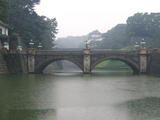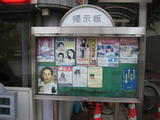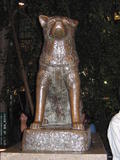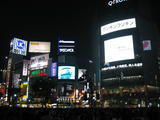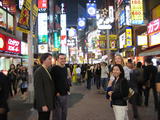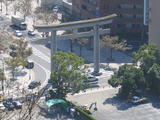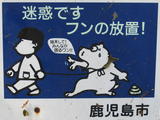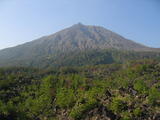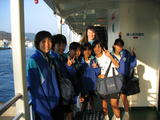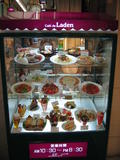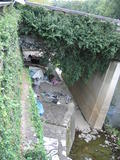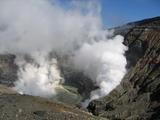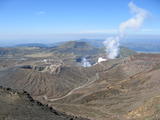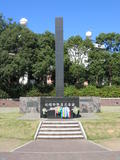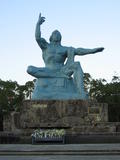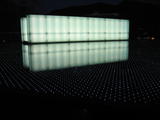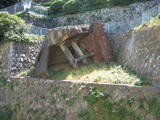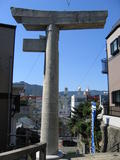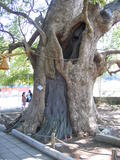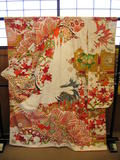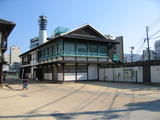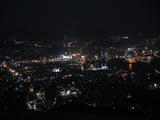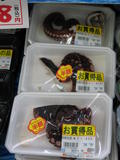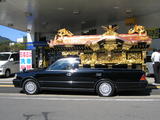| < < < Previous story | Next story > > > | |
Impressions of Japan and Nagasaki's historyTokyo, October 30th, 2004
Contents:General ImpressionsIn 1992 I did an internship in Tokyo, twelve years later I have finally returned. As I had really enjoyed Japan at the time the surprising thing for me is that it took so long to come back. My motivation to revisit Japan, was to show Maris this great country, to see what has changed in the last 12 years, to visit our friends Erik and Chisako who recently moved to Tokyo and to visit some friends that I had made during my previous stay in Japan. The great things that I remember about Japan still hold true today: Japan is probably the most advanced country in the world, at least in the technological and infrastructural sense. Take trains for example, they run on time, on the exact minute according to the schedule and train doors open exactly where the indications on the platform say they will be. Furthermore an extensive network of Shinkansen lines (the so-called bullet trains) allows you to travel vast distances in a few hours. Secondly, the food is just great! Every restaurant, whether cheap or expensive serves delicious food. There is a great variety of choice. I am particular fond of all the raw fish and noodles. It is clear that for the Japanese, food is of great importance, it has to taste nice and have a good presentation, so that it is not only a pleasure to the taste buds, but also to the eyes. But maybe most importantly, the boundless friendliness and helpfulness that the Japanese, and I literally mean nearly all of them, show towards foreigners. In Japan, foreigners are called gaijins. As a gaijin, you benefit twice from Japan, not only can you enjoy all the great things Japan has to offer, but you actually get more help and more freedom being a gaijin than if you were Japanese. As a gaijin you can make mistakes and get away with things that a Japanese person would never dare to do. This is referred to as the gaijin-license. So for example, not bowing low enough, might be seen as an insult, but if you are a gaijin, any bow will do. They interpret it positively, it shows that you are making an effort to understand their culture, but of course, as a gaijin, you can not be expected to understand the intricacies of bowing. A few more notably good things about Japan deserve to be mentioned as well. The Japanese, regardless of their job, have such pride in doing their work properly and as best they can, that you will experience a level of service unrivaled anywhere else in the world. Japan is also incredibly safe, you do not have to worry about the usual problems while traveling such as theft, overcharging or being ripped off. When I see the way Japanese visitors to my country are sometimes rather badly treated, I can only feel ashamed, because I always remember how well I was treated in Japan as a guest! There is really only one major downside: prices. But if you take into account how much better everything is here, then I think it is worth it. The natural disasters from which Japan is permanently at risk, could be considered as another downside, but the country is better prepared than most to deal with such events. During our stay there have been two typhoons and two earthquakes. Although we missed an earthquake in Tokyo by one day and did not notice the deadly earthquake of 6.8 on the Richter scale that hit Niigata on October 24th while we were in a moving train near Sendai (only 200km from the epicenter), we did feel the second big earthquake of 6.1 that hit Niigata on October 27th while we were in Tokyo (where it was felt as an earthquake of 3 on the Richter scale). We also experienced two typhoons during the first 2 weeks of our stay. The first one had a novelty interest for us, but the second was downright annoying. Though we realized later that several people had died in floods and mudslides, we were trying to visit some of the sights in Osaka, only to find out that everything was closed because of the typhoon. A typhoon, comes with an endless amount of rain, for two days, it rains without ever stopping. The only result of our excursion in Osaka during a typhoon was that we got completely soaked, as even an umbrella and raincoat barely helped. Between the typhoons, the weather was rather good, with lots of sunshine and clear skies. Armed with a 2 week Japan Rail pass, we traveled in real Japanese style, trying to see as many different things in the 2 weeks that our pass was valid. KyushuOn the first day, we took the train from Tokyo to Kagoshima (1468 kilometers) which took only 9 hours and 20 minutes (this included a 1 hour break in Osaka, where we had lunch)! Kagoshima is a city on a bay in the south of the island of Kyushu, overlooked by Sakurajima, an active volcano. Although there was no activity while we were there, view points around the volcano are dotted with bunkers in which to hide in the event of an eruption. On our way to our next destination, the Aso-san volcanic crater, we stopped in Kumamoto, where we visited a reconstructed castle and a Japanese garden. The castle, though good looking from the outside, turned out to be a concrete and steel construction, looking nothing like a castle on the inside. In other words it was completely fake. Aso-san, is said to be one of the most active volcanic craters. Fuming constantly, the area around it is sometimes closed because of poisonous gases. A bus takes you to the base of the crater, from where you can take an overpriced cable car to the rim. The alternative short walk up to the rim, was a better option. Busloads of school children also made it to Aso-san, many of whom, tried to overcome their shyness and say hello to us, the gaijins. After visiting the fuming crater, we decided to climb up Naka-dake, a mountain from which you have an excellent view over the crater. On top of the mountain, enjoying a serene "lunar" landscape, we were disturbed by large groups of surprisingly loud school children that also climbed up, as if it was a pleasant stroll. The schoolyard noise contrasted harshly with the view, again making things seem somewhat surreal. NagasakiAfter the volcanoes, it was time to revisit Nagasaki. I had visited Nagasaki back in 1992, where I had met Tomoko, a member of the Nagasaki Peace Foundation. Nagasaki has always had a particular significance for me, because, my mother and grandparents, who lived in the Dutch East Indies (present day Indonesia) at the start of the Second World War, had been detained in Japanese concentration camps from 1942 to 1945. My grandfather had been forced to work on the infamous Burma railway. He had managed to smuggle a little radio into the camp. Whenever they had to move camp, the radio, was taken apart and the components were hidden in bamboo sticks and other places by several of the prisoners. This was discovered by Japanese soldiers. He was charged with "spying for the Americans" and condemned to death! However before the sentence was carried out the United States managed to end the war with the use of the A-bomb on Nagasaki, effectively saving his life. It is a miracle that my mother and grandparents survived the Japanese concentration camps. But unfortunately the effects of my mother's internment in the camps did not end with the end of the war, as my mother was only one year old when she was imprisoned. The Japanese gave their prisoners too little food, and in spite of my grandmother sparing everything she could for her two children my mother was seriously underfed. Being so young her womb did not develop properly and I being her first born child was born with a congenital deformation to my legs. As a result for my entire life I need an artificial limb to be able to walk. Something that could have been prevented with just a few more bowls of rice for my mother when she was a baby! I must add that the Japanese, that were interned, for a shorter period of time and under much better conditions, by the United States during the Second World War have all received a significant compensation back in the 1950s. But to this day the Japanese government refuses to apologize and compensate the victims of its concentration camps. Visiting Nagasaki therefore gives me very mixed feelings. The effects of the bomb on Nagasaki is well shown in the A-bomb museum. It is in one word, horrifying. Many who did not die in the initial explosion, died of burns or dehydration (there was no water) shortly thereafter. Later even more people died of the effects of radiation. The heat produced by the explosion was 7000 degrees Celsius at its core, that is more than on the surface of the sun! 70.000 people died nearly immediately and several tens of thousands more died afterwards from the after effects. Though the Nagasaki city council, counts every person who was near the explosion who has died since, whether from a car accident or cancer, as a victim. Nagasaki's computerized register of victims contains only the names of Japanese victims, but not (yet?) those of other nationalities. In spite of the fact that more than 10.000 of the victims were Korean and some 200 were allied prisoners of war forced to work in the Mitsubishi arms factory. In 1992 the museum was very factual, and that was the first time that I saw the other side, so to speak. Reading one of the stories tears came to my eyes, and it was at that moment that Tomoko from the Nagasaki Peace Foundation invited me for a talk. The museum has since been reconstructed. The new museum makes more of a multimedia show of the event. Unfortunately it is somehow taken out of its historical context (though there is some information tucked away in a corner). The high number of US casualties during to battle for Okinawa, and the even higher number of Japanese casualties, who fought to the death and preferred suicide over surrender, led to an estimate that a conventional invasion of Japan, would have cost another 100.000 U.S. soldiers their lives as well as 1 million Japanese soldiers and civilians. Furthermore every day that the war continued was going to cause more people to die at the hands of Japanese Imperial forces (as for example in Kanchanaburi). One of them would have been my own grandfather. Crimes comitted by the Japanese Imperial Army, such as the Nankin massacre, in which anywhere from 100.000 to 300.000 people were killed (depending on the source) and the use of Chinese prisoners for live target practice, are not mentioned either. Neither are the Japanese concentration camps of which my family was a victim. Entering the peace park, confronts you with prominently placed statues from such "peace loving" countries as the Soviet Union, given to Nagasaki in 1985 while it was still oppressing, Eastern Europe, the Baltic States and several other countries that had been forced into the Soviet Union against their will. Another "peace loving" country the German Democratic Republic donated a statue in 1981, while it was shooting any person who dared to try to escape from this communist paradise. In the beginning of the 80s these same two "peace loving" countries pointed short range nuclear missiles at Western European cities, kicking off a continental nuclear arms race. Which seems rather contradictory with Nagasaki's aim to create a world free of nuclear weapons. More sincere donations such as statues from two of Nagasaki's sister cities, St Paul in the U.S.A. and Middelburg in The Netherlands unfortunately have a much less prominent placing. Given my family's history in Japanese concentration camps and the result it had on me, you may wonder why I love Japan so much. Although history should not be forgotten, it should not be used as an excuse to perpetuate hatred which in turn may lead to new wars. Furthermore the Japan that I love, is the present day Japan, with all the qualities that I have exposed earlier in this story as well as its people and the boundless kindness that they have always shown me. Fortunately there is also some positive history in Nagasaki. It is a city where from 1641 to 1854, a small Dutch outpost, on a small artificial island called Dejima, used to be Japan's only connection to the outside world. The previous Portuguese occupants of Dejima, had abused their preferential status, by trying to introduce Christianity into Japan in spite of strict agreements to limit their activities to trade. This violation of trust was not appreciated by the Japanese, so they evicted the Portuguese and instead gave the Dutch a sole trading concession. The Dutch were seen, rightly so, as being more interested in trade than in religion. Nowadays the island has disappeared as the sea around it was reclaimed, but a Nagasaki city project is slowly recreating the island, moving roads, buildings, tram lines and digging a canal around the perimeter. As this is in the middle of the present day downtown area, one can only imagine how expensive this project is! Some buildings have already been reconstructed, and the outline of the island has partially been made visible. The current phase of the project will be completed by 2010, but the final phase may last until 2020. The historical ties between Japan and Holland are still somehow present in Japanese minds. Whenever someone asks me where I am from, the answer "Holland" is greeted with special enthusiasm. The rest of our trip in Japan will be covered in the next update. If you would like to be notified or no longer want to be notified of travel updates send me an e-mail. e-mail Otto de Voogd PhotosTokyoKagoshimaKumamotoAso-sanNagasakiPractical Information
To my knowledge the information provided here was accurate
at the time of our visit. However time passes and things can change.
TravelProbably the best way to travel around Japan is by train. A Japan Rail pass can be a real bargain if you plan to travel a lot, but it must be bought outside of Japan. It is valid for either 1, 2 or 3 weeks. InformationEvery major station has a good tourist information booth, sometimes a special one for foreigners. They are very helpful and can tell you more or less everything you need to know. CostsJapan - Yen, approx. rates 1 USD = 107 JPY, 1 EUR = 136 JPY
A Japan Rail pass for 2 weeks: 45,100 JPY (363 EUR + 20 EUR costs).
| ||
| < < < Previous story | Next story > > > | |
New | About | Contact | Connect | Friends | Promotions | Copyright | Advertise
